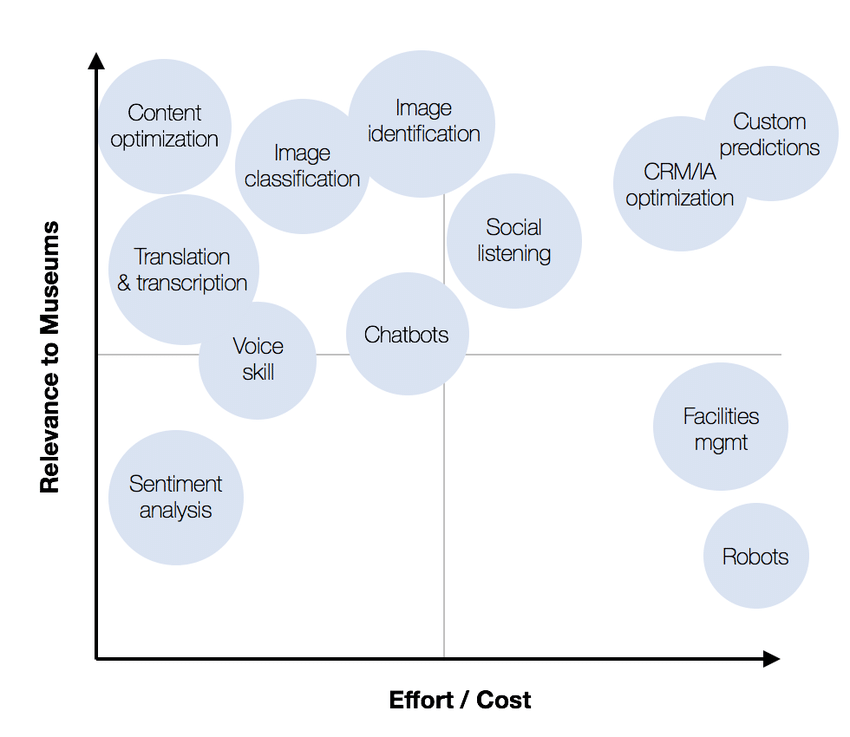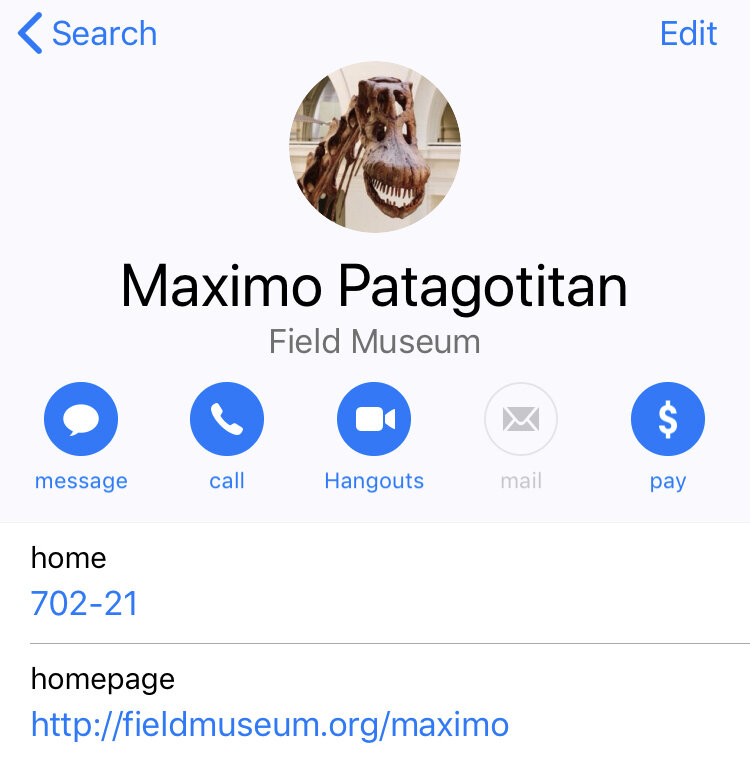To improve museum operations, museum management is increasingly taking advantage of artificial intelligence (AI) technology to understand their collection data, their visitors, and their exhibitions. Audience engagement is one of the most significant factors that museums need to consider in their operations: it is an implicit element that connects people to collections and should be achieved based on a deep understanding of visitors, collections, and exhibitions. Within the past few years, AI technologies have shown their potential to bring previously inaccessible insights to museums based in three main areas: machine learning, chatbots, and neural networks.
The article will discuss the opportunities and challenges that AI can bring to museums with specific examples and will introduce recent trends in AI technologies used in museum audience engagement.
Recent Trends
Increasing implementation
In “AI, Visitor Experience, and Museum Operations: A Closer Look at the Possible,” researchers conducted a search based on AI initiatives in museums on the internet, case studies presented in museum conferences, and journal databases, which surfaced sixty-one examples from year 2010 to 2018. Although the search resulted in a small sample size compared to the total number of museums in the U.S., and even though the AI initiatives in the results are not elaborately identified, the figure still shows a clear trend of increasing implementation of AI technologies over the past ten years.
Figure 1: Timeline of AI initiatives in museums (2010 - 2018) (N = 61 examples). Source: Elena Villaespesa, ResearchGate.
Machine learning and computer vision
According to French and Villaespesa, one of the most promising technologies is the application of computer vision for museum collections. The term “computer vision for museum collections” includes data analyzing collections’ color, shape, the direction of lines, spaces, light, and even facial recognition. Based on those analyzed factors, the algorithm is able to provide matches between collections to allow curators to be creative and explore more potentials. The AI subcategory that drives “computer vision” is actually machine learning, a technology that learns, categorizes, and make predictions based on data. Identified as “machine learning for visitation pattern prediction and experience evaluation,” this technology can also collect data from the visitors’ physical experience and from all the different digital touchpoints of that journey: web, social media, ticketing, and mobile apps, among others.
Future investment opportunity
In “AI, Visitor Experience, and Museum Operations: A Closer Look at the Possible,” French and Villaespesa also break down the different levels of operational feasibility for possible AI subcategories that can be invested in in the future.
Figure 2: Popular AI subcategories, mapped to axes of museum relevancy and effort/cost. Source: Elena Villaespesa, ResearchGate.
The left quadrants represent what could be applied with the help of a partner or in-house resource, and right quadrants describe what would likely involve a commercial product or partner at an additional cost. The areas with high relevance to museums and a lower barrier to entry are largely related to museum content. Although the future AI-driven insights are still unclear due to the changing environment of the research, the visualization still points out possible trends since AI usage in museums is often circumscribed by a “pilot project” approach, which involves significant time and resources to prepare data inputs.
Museum-published digital content
Last but not least, French and Villaespesa point out that there has never been a better time to reevaluate museum-published digital content. With all the technologies at hand, museums are expected and will be able to create more personalized digital experiences for visitors. The opportunities for AI will not only lie within the implementation of new technology, but will also assist with exhibiting contents. Examples of AI-driven exhibiting content will be introduced later in this article.
Combining the results of this research and other practical utilizations, there are three main AI subcategories that are implemented to engage audiences in museums: machine learning, chatbots, and neural networks. This article will introduce them next with specific examples to discuss the opportunities and challenges in each path.
Machine Learning
As previously explained, machine learning technology can be used to collect, categorize, and analyze data. The interesting factors found from machine learning can not only be used to track audience behavior or categorize collections, but can be used in interactive activities for visitors. MoMA’s Digital Media team has collaborated with Google Arts & Culture Lab and introduced a machine learning algorithm that can comb through over 30,000 exhibition photos, looking for matches with more than 65,000 works in MoMA’s online collection. With over 20,000 recognized artworks, a vast network of new links was created between exhibition history and online collections. This project will bring visitors from a specific collection to a dated exhibition, and thus, evolves a more impressive and personalized experience.
The project has some limitations. To achieve the standards of high-quality collections and highly accurate matches, the identified matches are limited. Additionally, as many collections in the project do not belong to MoMA, there is a need for extra access to expand the project. With that in mind, museums need to follow up by sharing resources. As exhibits and collections are transferred back and forth among museums, access to online, two-dimensional images needs to be discussed for release as well.
Chatbots
Chatbots are used for museums to communicate with visitors in a more sufficient and efficient way. There here are two main types of chatbot technology in use. The first is the voice-based virtual assistant. The other uses messaging apps to answer questions. Most of the implementations in museums are aiming to provide better customer service and personalized touring. A unique example of chatbot use in a museum is from the Field Museum in Chicago, where a chatbot, Máximo Patagotitan, is used in a dinosaur exhibition to offer transactional information based on the questions that visitors ask it. The chatbot’s personality was created based on visitor activities, which collected possible queries and tied logic between questions. Because of the nature of these tasks, museum professionals with digital communication backgrounds may bring essential contributions to make chatbot work.
As technology gets relatively mature, the challenges for chatbots lie in the content’s creativity. As it becomes more and more common for museums to have chatbots, what kinds of chatbots can actually engage with audiences better and communicate more sufficiently will become the next question.
Neural Networks
Neural networks are used in Archival Museum Research and Generative Adversarial Networks (GANs). GAN is a system that includes two neural networks—a discriminator and a generator—one for recognizing data and one for simulating similar data. Artists can use the system as a creative assistant to recreate their working style. Museums also utilize it to develop interactive activities for audiences.
Archival Museum Research in museums can also utilize neural network technology to gain profound insights into the collections. Research based on the National Herbarium of the National Museum of Natural History in Washington, D.C., demonstrates that digital neural networks are capable of distinguishing between two similar families of plants with rates of accuracy well over 90 percent. This indicates all sorts of possibilities for scientists and academics going forward. The “deep learning” algorithms will enable museum archivists to find underlying connections within collections and will be able to test scientific hypotheses rapidly. Another example happened in the Vatican Secret Archives, one of the grandest historical collections in the world, with numbers of illegible handwritten collections. The new project, known as In Codice Ratio, uses a combination of artificial intelligence and optical character recognition (OCR) software to make their transcripts available.
Challenges exits in those breakthroughs. As Mark Algee-Hewitt points out, “it is almost impossible to reconstruct why and how a neural network makes its decisions” once it has been conditioned. Determinations left to computer programs should always be uncomplicated and verifiable if they are to be trusted. Although scientists successfully used the algorithm to entangle the collections, there is still a long way to go to massively utilize neural networks in museum collections.
Conclusion
Seeing the opportunities of AI technologies in museums, challenges are the need for algorithm accuracy, digital content access, and content’s creativeness. No matter how far AI technologies can go, it is always essential to ensure that audience engagement is based on the understanding of the museum, its collection, and its audiences. What’s more, in the long run, museums need to be aware of letting audiences lead the exhibition curatorial contents. The technologies are developed to connect audiences with the museums, but should not become the shackles that stop museums presenting artworks in their own way.
Resources
“A HALL OF AN INNOVATION: National Soccer Hall of Fame to use facial recognition for fan experience.” August 21, 2018. https://www.frontrowsoccer.com/2018/08/21/a-hall-of-an-innovation-national-soccer-hall-of-fame-to-use-facial-recognition-for-fan-experience/.
“AI: The Rise Of A New Art Movement.” Obvious Art. Last modified February 14, 2018. http://obvious-art.com/blog-post.html.
Anstey, Tom. “Barnes Foundation uses intelligent machines to offer new ways of interpreting art collections.” Attractions Management. July 17, 2018. https://www.attractionsmanagement.com/index.cfm?pagetype=news&codeID=338394.
“ARTIFICIAL INTELLIGENCE Technology Landscape.” Callaghan Innovation. Accessed March 9, 2020. https://www.callaghaninnovation.govt.nz/sites/all/files/callaghan-innovation- infographic-artificial-intelligence.pdf.
Bertagnoli, Lisa. “Art Institute uses data to give visitors what they want.” Chicago Business. May 18, 2018. https://www.chicagobusiness.com/article/20180518/ISSUE01/180519840/art-institute-of-chicago-uses-data-to-make-exhibit-choices.
Charr, Manuel. “How Are Museums Using Chatbots?” MuseumNext. September 14, 2019. https://www.museumnext.com/article/how-are-museums-are-using-chatbots/.
Chen, Lin. "Online to Offline: Artificial Intelligence helps to design a personalized museum in the digital era." Pratt. March 5, 2019. https://museumsdigitalculture.prattsi.org/online-to-offline-artificial-intelligence-helps-to-design-a-personalized-museum-in-digital-era-236164bbb4fa.
Ciecko, Brendan. “4 Ways AI is the Next Big Game-Changer in Museum Membership & Attendance.” Sg Engage. August 1, 2019. https://npengage.com/arts-cultural/artificial-intelligence-museum-membership/.
Falk, John H. (John Howard), and Lynn D. Dierking. Learning from Museums : Visitor Experiences and the Making of Meaning Walnut Creek. CA: AltaMira Press, 2000.
“GenStudio.” GitHub. Last modified December 16, 2019. https://github.com/microsoft/GenStudio.
“Homepage.” Gen Studio. Accessed March 9, 2020. https://gen.studio.
“Homepage." Google Arts and Culture. Accessed March 9, 2020. https://artsandculture.google.com/.
“Homepage." Knight Foundation. Accessed March 9, 2020. https://knightfoundation.org/articles/five-takeways-on-how-museums-are-adapting-to-digital-age-demands/.
“Identifying art through machine learning— A project with Google Arts & Culture Lab.” MoMA. Accessed March 9, 2020. https://www.moma.org/calendar/exhibitions/history/identifying-art.
Kean, Sam. “Artificial Intelligence Is Cracking Open the Vatican's Secret Archives.” The Atlantic. April 30, 2018. https://www.theatlantic.com/technology/archive/2018/04/vatican-secret-archives-artificial-intelligence/559205/.
Kinsella, Eileen. “The Met Museum Envisions a Future Where Artificial Intelligence Helps You Find #Art Posts for Your Instagram.” Artnet News. February 5, 2019. https://news.artnet.com/art-world/the-met-ai-1456774.
Lee, Dami. “Deepfake Salvador Dalí takes selfies with museum visitors.” The Verge. March 10, 2019. https://www.theverge.com/2019/5/10/18540953/salvador-dali-lives-deepfake-museum.
Litt, Steven. “Dot, the new Akron Art Museum chatbot, wants to get you talking about art and life.” Last modified Jan 30, 2019. https://www.cleveland.com/arts/2018/08/dot_the_new_akron_art_museum_c.html.
Löfwander, Simon. “About Artificial Intelligence, Neural Networks & Deep Learning.” AYIMA. January 24, 2017. https://www.ayima.com/blog/artificial-intelligence-neural-networks-deep-learning.html.
“Museum & New Intelligence— A primer for attendees.” American Alliance of Museums. Accessed March 9, 2020.
Rao, Seema. “What is audience engagement?” Museum Two. October 1, 2019. http://museumtwo.blogspot.com/2019/10/what-is-audience-engagement.html.
Sikorsky, Michael, and Rita Gunther McGrath. “Bots Are about to Get Better at Customer Support than Humans.” WIRED UK. December 19, 2017. https://www.wired.co.uk/article/message-bot-customer-care.
Smith, Ryan P. “How Artificial Intelligence Could Revolutionize Archival Museum Research.” Smithsonian Magazine. November 3, 2017. https://www.smithsonianmag.com/smithsonian-institution/how-artificial-intelligence-could-revolutionize-museum-research-180967065/.
Soracco, Anna. “How Gen Studio was created for The Met using Microsoft AI.” Channel9. March 4, 2019. https://channel9.msdn.com/Shows/AI-Show/Gen-Studio.
Styx, Lauren. “How are museums using artificial intelligence, and is AI the future of museums?” Museum Next. March 28, 2019. https://www.museumnext.com/article/artificial-intelligence-and-the-future-of-museums/.
Tallon, Loic. “Sparking Global Connections to Art through Open Data and Artificial Intelligence.” Met Museum. February 4, 2019. https://www.metmuseum.org/blogs/now-at-the-met/2019/met-microsoft-mit-art-open- data-artificial-intelligence.
Vermeeren, Arnold., Licia. Calvi, and Amalia. Sabiescu. Museum Experience Design Crowds. Ecosystems and Novel Technologies 1st ed. 2018. Cham: Springer International Publishing, 2018.
Villaespesa, Elena & French, Ariana. “AI, Visitor Experience, and Museum Operations: A Closer Look at the Possible.” ResearchGate, April 2019. https://www.researchgate.net/publication/ 333852865_AI_Visitor_Experience_and_Museum_Operations_A_Closer_Look_at_the_Possible.
Vincent, James. “A never-ending stream of AI art goes up for auction.” The Verge. March 5, 2019. https://www.theverge.com/2019/3/5/18251267/ai-art-gans-mario-klingemann-auction-sothebys-technology.




